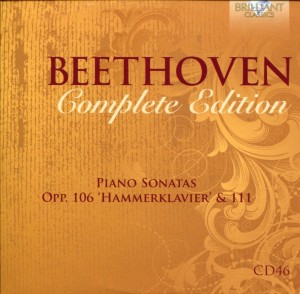It’s hard to believe how fresh and crystal-clear this sounds. The piano sontas, performed by the incomparable Alfred Brendel, were recorded in 1962-64, when Brendel was in his early thirties. Yet, they sound like they were recorded yesterday.
Another masterful job by Brilliant Classics, the best label in the world for affordable, high-quality Classical music.
These piano sontas have the qualities that, say, Artur Rubinstein‘s The Chopin Collection does. Most of those recordings were made in the 1950s and 60s. Yet, they sound beautiful. Rich, resonate, and warm.
Beethoven Piano Sonata No. 29 in B Flat Op. 106 “Hammerklavier”
According to its entry on Wikipedia,
Ludwig van Beethoven’s Piano Sonata No. 29 in B-flat major, Op. 106 (known as the Große Sonate für das Hammerklavier, or more simply as the Hammerklavier) is a piano sonata widely considered to be one of the most important works of the composer’s third period and among the greatest piano sonatas. It is widely considered to be Beethoven’s technically most challenging piano composition and one of the most challenging solo works in the classical piano repertoire.
Dedicated to his patron, the Archduke Rudolf, the sonata was written primarily from the summer of 1817 to the late autumn of 1818, towards the end of a fallow period in Beethoven’s compositional career. It represents the spectacular emergence of many of the themes that were to recur in Beethoven’s late period: the reinvention of traditional forms, such as sonata form; a brusque humour; and a return to pre-classical compositional traditions, including an exploration of modal harmony and reinventions of the fugue within classical forms.
The Hammerklavier also set a precedent for the length of solo compositions (performances typically take about 45 minutes). While orchestral works such as symphonies and concerti had often contained movements of 15 or even 20 minutes for many years, few single movements in solo literature had a span such as the Hammerklavier’s Adagio sostenuto.
The sonata’s name comes from Beethoven’s later practice of using German rather than Italian words for musical terminology. (Hammerklavier literally means “hammer-keyboard”, and is still today the German name for the fortepiano, the predecessor of the modern pianoforte.)
Indeed. “One of the most challenging solo works in the Classical piano repertoire” required Alfred Brendel to pull it off.
And he did.
Beautifully.
As the Wiki article notes, Hammerklavier was Continue reading

